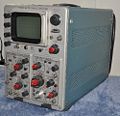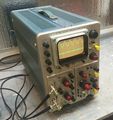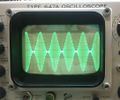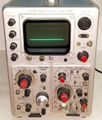647A
The Tektronix 647A is an improved version of the 647, with the main enhancement being doubling the bandwidth to 100 MHz.
Tek also introduced three new plug-ins with the 647A. The 10A2A is an improved version of the dual channel 10A2 vertical plug-in, with bandwidth extended to 100 MHz. The 11B2A is similar to the 11B2 dual time base, but triggers up to 100 MHz. In addition, Tek introduced the 10A1 differential amplifier. It operates down to 1 mV/div sensitivity, and includes a comparison voltage mode with a calibrated DC offset similar to that first offered in the type W plug-in. The maximum bandwidth of the 10A1 is 55 MHz for sensitivities of 5 mV/div and higher.
In total, only 4 plug-ins were developed for the 647 series – the generic dual trace vertical, a differential vertical, and a single and a dual time base. Although it combined high performance with rugged reliability and compactness, the 647 series was one of Tek’s “orphan” scope series, a result of when it was introduced. By the time the 100 MHz 647A was announced, the majority of the R&D effort at Tek was devoted to the 7000 series, which introduced just two years later, in 1969. The entry level 7000 series mainframe started with performance nearly the same as the top of the line 647A. With on-screen scale factor read-out, and even more compact form factor, 7000 would offer many advantages over any of Tek’s existing lines of scopes. When the work on developing plug-ins for 7000 series was ramping up, no additional plug-ins for any of the “legacy” plug-in scopes would be developed. For the 530/540/550 series which started over 20 years earlier, a large family of plug-ins were available. But for the orphan scopes which were introduced in the mid 1960s, the variety of plug-ins was very limited.
The 067-0544-00 is a calibration plug-in for the 647A.
Key Specifications
| Bandwidth | DC to 100 MHz (≤ 3 dB) with Type 10A2A plug-in |
|---|---|
| Rise time | 3.5 ns |
| Acceleration voltage | 14 kV |
| Screen Area | 6 cm × 10 cm |
| Power | 108/115/122/216/235/244 VAC ±10%,selected via primary voltage selector and voltage range selector switches, 50 Hz to 60 Hz; 185W with 10A2 & 11B2 plug-in |
| Operating Temperature | -30 C° to +65 C° |
| Cooling | AC Fan (only in rack variant) |
| Thermal Protection | Automatic resetting thermal cutout, in case internal temperature exceeds safe operating level |
| Construction | Aluminum alloy chassis. Anodized front panel |
| Weight | 40.5 lbs / 18.4 kg |
Internals
The vertical amplifier contained in the 647A indicator unit (mainframe) consists of NPN and PNP bipolar transistors. The output transistors, Q484 and Q494, are selected 2N3866 NPN transistors. The datasheet for the 2N3866 lists Its transit frequency as 800 MHz and specifies an absolute maximum value of Vceo of 30 V. The quiescent value of Vce on Q484 and Q494 is about 30 V. So it seems likely that the selection process for these transistors involved testing their performance at the high end of their specified voltage range, and probably beyond.
The power supply of the 647A is all solid state, with a zener voltage reference and NPN pass transistors. The horizontal amplifier in the 647A uses selected 2N3119 NPN bipolar transistors for the output. These are specified as having a transit frequency of 250 MHz and a Vceo max of 80 V.
Related
The Hungarian company Elektronikus Mérőkészülékek Gyára (EMG) produced a clone of 647A, the TR-4653, in the 1970s.
Pictures
-
647A front view
-
647A left view
-
647A right view
-
647A rear view
-
R647A front view
-
R647 inside view
-
Special R647A for US Air Force
-
Rear panel of the Air Force R647A
-
-
-
-
-
-
-
-
-
-
-
-
-
-
-
-
























